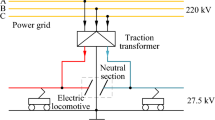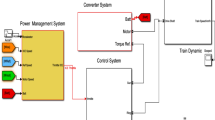Abstract
Rail transport has always been one of the greatest economic boosters of several world nations, allowing the freight and passenger transport. In addition, it is the most secure and economic land transportation mode. From the energetic perspective, the electric locomotives emerge as one of the most efficient land transportation mode, as well as allow a more sustainable development. However, when an electric locomotive is connected to the three-phase power grid, power quality (PQ) deterioration arise, leading to the distortion and unbalance of the three-phase power grid currents and voltages which imply higher operational costs, raising economic and functional issues. In order to overcome the PQ deterioration phenomena, several solutions based power electronics technology have been studied and developed. These solutions vary in terms of control, functionality, implementation costs and complexity. One of the existing solutions is a static synchronous compensator (STATCOM), which compensates the three-phase currents imbalance and harmonics.
In this paper, a comprehensive review of the electrified railway systems is carried out, identifying the electric PQ phenomena which may appear due to the non-linear dynamic traction loads. Following this topic, a computational simulation of the STATCOM is presented, making analysis of its behavior regarding the PQ improvement in electrified railway systems. Two case studies are presented: (i) a traction power system fed with V/V power transformer; (ii) a traction power system fed with Scott power transformer.
Access this chapter
Tax calculation will be finalised at checkout
Purchases are for personal use only
Similar content being viewed by others

Abbreviations
- iComp_A, iComp_B, iComp_C:
-
Instantaneous current compensation value synthesized by STATCOM in phase A, phase B and phase C, respectively
- iComp_A*, iComp_B*, iComp_C*:
-
Instantaneous reference value for phase compensation current A, current B and current C, respectively
- iRail_A, iRail_B, iRail_C:
-
Instantaneous Phase A, Phase B and Phase C current of the power transformer primary windings (Scott or V/V)
- iS_A, iS_B, iS_C:
-
Three-phase power grid instantaneous current value of phase A, phase B and phase C
- ix, iy:
-
Instantaneous current value of catenary x and catenary y
- vS_A, vS_B, vS_C:
-
Instantaneous voltage value of the phase A, phase B and phase C of the power grid
- vx, vy:
-
Instantaneous voltage value of catenary x and catenary y, at the secondary windings of the power transformer (Scott or V/V)
References
Brenna, M., Foiadelli, F., Zaninelli, D.: Electrical Railway Transportation Systems, vol. 67. Wiley, Piscatawaya (2018). ISBN: 978-1-119-38680-3
Frey, S.: Railway Electrification. White Word Publications, Delhi (2012). ISBN:978-81-323-4395-0
Mazzino, N., Perez, X., Furio, N., et al.: Rail 2050 Vision: Rail-the Backbone of Europe’s Mobility. ERRAC-The European Rail Research Advisory Council, Technical report (2017)
Targosz, R., Chapman, D.: Application note-cost of poor power quality, Leonardo Energy (2012)
Luo, A., Wu, C., Shen, J., Shuai, Z., Ma, F.: Railway static power conditioners for high-speed train traction power supply systems using three-phase V/V transformers. IEEE Trans. Power Electron. 26(10), 2844–2856 (2011). https://doi.org/10.1109/TPEL.2011.2128888
Tanta, M., Monteiro, V., Sousa, T.J., Martins, A.P., Carvalho, A.S., Afonso, J.L.: Power quality phenomena in electrified railways: conventional and new trends in power quality improvement toward public power systems. In: Young Engineers Forum (YEF-ECE), 2018 International, pp. 25–30 (2018). https://doi.org/10.1109/YEF-ECE.2018.8368934
Lao, K.-W., Wong, M.-C., Dai, N.: Co-phase Traction Power Supply with Railway Hybrid Power Quality Conditioner. Springer, Singapore (2019). https://doi.org/10.1007/978-981-13-0438-5. ISBN: 978-981-13-0438-5
Lao, K.-W., Wong, M.-C., Dai, N., Lam, C.-S., Wang, L., Wong, C.-K.: Analysis of the effects of operation voltage range in flexible DC control on railway HPQC compensation capability in high-speed co-phase railway power. IEEE Trans. Power Electron. 33(2), 1760–1774 (2018). https://doi.org/10.1109/TPEL.2017.2684427
Steimel, A.: Electric Traction - Motive Power and Energy Supply: Basics and Practical Experience. Oldenbourg Industrieverlag, Munich (2008). ISBN: 978-3-8356-3132-8
Gazafrudi, S.M.M., Langerudy, A.T., Fuchs, E.F., Al-Haddad, K.: Power quality issues in railway electrification: a comprehensive perspective. IEEE Trans. Industr. Electron. 62(5), 3081–3090 (2015). https://doi.org/10.1109/TIE.2014.2386794
Abrahamsson, L., Schütte, T., Östlund, S.: Use of converters for feeding of AC railways for all frequencies. Energy. Sustain. Dev. 16(3), 368–378 (2012). https://doi.org/10.1016/j.esd.2012.05.003
Lee, K.: Advances in the application of power electronics to railway traction. In: 2015 6th International Conference on Power Electronics Systems and Applications (PESA), pp. 1–4 (2015). https://doi.org/10.1109/pesa.2015.7398960
Serrano-Jiménez, D., Abrahamsson, L., Castaño-Solis, S., Sanz-Feito, J.: Electrical railway power supply systems: Current situation and future trends. Int. J. Electr. Power Energy Syst. 92, 181–192 (2017). https://doi.org/10.1016/j.ijepes.2017.05.008
Xu, Q., et al.: Analysis and comparison of modular railway power conditioner for high-speed railway traction system. IEEE Trans. Power Electron. 32(8), 6031–6048 (2017). https://doi.org/10.1109/TPEL.2016.2616721
Ma, F., et al.: A railway traction power conditioner using modular multilevel converter and its control strategy for high-speed railway system. IEEE Trans. Transp. Electrif. 2(1), 96–109 (2016). https://doi.org/10.1109/TTE.2016.2515164
Pinto, J., Tanta, M., Monteiro, V.D.F., Barros, L.A., Afonso, J.L.: Active power conditioner based on a voltage source converter for harmonics and negative sequence components compensation in electrified railway systems. In: Proceedings of 7th Transport Research Arena TRA 2018 (2018). https://doi.org/10.5281/zenodo.1491309
Acknowledgements
This work has been supported by FCT – Fundação para a Ciência e Tecnologia with-in the Project Scope: UID/CEC/00319/2019. This work has been supported by the FCT Project QUALITY4POWER PTDC/EEI-EEE/28813/2017, and by the FCT Project DAIPESEV PTDC/EEI-EEE/30382/2017. Mr. Luis A. M. Barros is supported by the doctoral scholarship PD/BD/143006/2018 granted by the Portuguese FCT foundation. Mr. Mohamed Tanta was supported by FCT PhD grant with a reference PD/BD/127815/2016.
Author information
Authors and Affiliations
Corresponding author
Editor information
Editors and Affiliations
Rights and permissions
Copyright information
© 2020 ICST Institute for Computer Sciences, Social Informatics and Telecommunications Engineering
About this paper
Cite this paper
Barros, L.A.M., Tanta, M., Martins, A.P., Afonso, J.L., Pinto, J.G. (2020). STATCOM Evaluation in Electrified Railway Using V/V and Scott Power Transformers. In: Afonso, J., Monteiro, V., Pinto, J. (eds) Sustainable Energy for Smart Cities. SESC 2019. Lecture Notes of the Institute for Computer Sciences, Social Informatics and Telecommunications Engineering, vol 315. Springer, Cham. https://doi.org/10.1007/978-3-030-45694-8_2
Download citation
DOI: https://doi.org/10.1007/978-3-030-45694-8_2
Published:
Publisher Name: Springer, Cham
Print ISBN: 978-3-030-45693-1
Online ISBN: 978-3-030-45694-8
eBook Packages: Computer ScienceComputer Science (R0)



